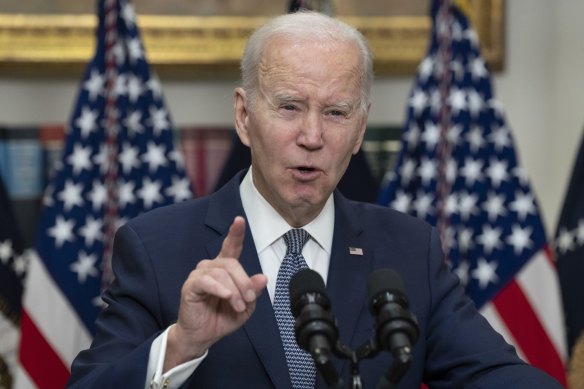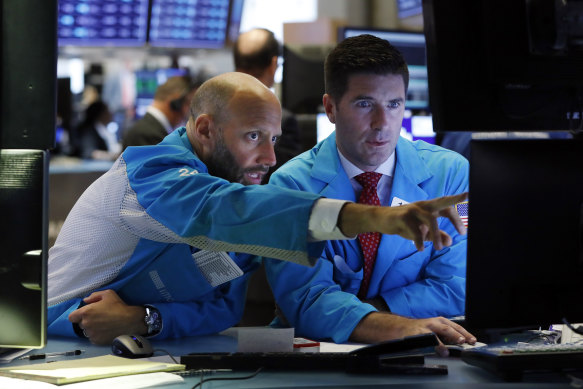This was published 1 year ago
Opinion
X-Day: The US is getting closer to running out of money
Stephen Bartholomeusz
Senior business columnistUS House Republicans finally passed a bill last night to raise the US government’s debt ceiling. Paradoxically, that brings the US closer to a default on its $US31 trillion ($47 trillion) of government debt.
By the narrowest of margins – 217 to 215 – the Republicans used their slim majority to pass a bill that has no chance of being endorsed by the Democrat-controlled Senate and which would be vetoed by the Biden White House even if it did.

The Republicans know the bill has no prospect of being enacted, but want to use its existence as leverage to force Joe Biden to negotiate big spending cuts to programs.Credit: Bloomberg
That’s because the nature of the spending cuts envisaged by the bill makes it unacceptable to the Democrats. It proposes raising the $US31.4 trillion ceiling until March next year or until the debt has increased by $US1.5 trillion, whichever is earlier.
The Republicans’ proposal would cut deficits by $US4.8 trillion over the next decade by savaging Joe Biden’s climate and clean energy spending, reducing spending on social welfare, Medicaid and food stamps. It would also block Biden’s plan to forgive hundreds of billions of dollars of student loans, among other cuts to education spending.
They also want to speed up leasing of the permitting of oil and gas and other fossil fuel exploration and production.
If their bill were enacted, it is estimated it would cut America’s debt-to-GDP ratio by about nine percentage points over a decade. Biden’s latest budget, which includes tax increases for wealthy Americans, would reduce that ratio by about six percentage points.
The Republicans know that the bill has no prospect of being enacted but want to use its existence as leverage to force Biden to negotiate big spending cuts to programs they detest as the price of raising the debt ceiling. If successful, there would also be major political benefits from destroying Biden’s environmental and social programs ahead of next year’s elections.
The Republicans want to force Biden to fold to avoid a default on the debt that would likely cause chaos in financial markets and damage the US economy.
Biden has said he is prepared to negotiate over budget issues, but only if those discussions are de-linked from the debt ceiling, which he wants raised unconditionally.
It’s a bizarre situation. The debt at the centre of the stand-off relates to spending that Congress has previously authorised. It’s not related to new spending proposals. Also, the biggest contribution to the rapid increase in the government’s debt in recent years occurred during the Republican’s Trump administration. In those four years, the debt grew from about $US20.5 trillion to $US27.7 trillion.

A default on the debt that would likely cause chaos in financial markets and damage the US economy.Credit: AP
US Treasury is already using “extraordinary measures” to avoid breaching the existing debt ceiling, using redemptions of investments, deferrals of spending and suspensions of contributions to government pension funds to push out the day of reckoning – the “X-Day” on which it hit the ceiling and was forced to default on at least some of its payments.
That day may have been brought forward from previous forecasts of August/September to, according to Goldman Sachs, as soon as early June by lower-than-expected tax receipts this month.
There have been various forecasts of the damage a default would do, although they are stabs in the dark, given that it is impossible at this stage to predict how Treasury would try to operate after a default – whether they would keep paying the interest and principal on government bonds while savaging spending elsewhere, for instance.
Could Treasury issue the trillion dollar platinum coin to the Federal Reserve in exchange for newly-printed cash, as some have suggested?
Regardless, if there were a default, the economic effects would inevitably be negative and the financial market effects potentially chaotic.
While there’s regularly been brinkmanship around the debt ceiling, the closest the US got to a default was in 2011.
As that X-date loomed, bond yields spiked, bond market liquidity fell and the sharemarket slumped, falling about 18 per cent during that period. The US lost its AAA credit rating from Standard & Poor’s and the episode is estimated to have cost Treasury about $US1.3 billion in extra borrowing costs that year.
Fed Reserve simulations have estimated that a one-month default during which Treasury maintained all interest payments would increase 10-year Treasury bond yields by 80 basis points, lead to a 30 per cent fall in the sharemarket, a 10 per cent depreciation of the US dollar, a 1.25 per cent increase in the unemployment rate in the first year and 1.7 percentage points in the second.

The biggest contribution to the rapid increase in the government’s debt in recent years occurred during the Trump administration.Credit: AP
The Brookings Institute has said that an increase in unemployment of the same magnitude today would cost about two million jobs in 2023 and 2.8 million in 2024.
The international implications of a previously unthinkable default by the US on its debts would also be severe.
In the near time there could be chaos in financial markets and a flight from the US dollar. Longer term it would aid those seeking to undermine the dollar’s status as the world’s reserve currency and would significantly diminish the appeal of lending to, or investing in, the US.
The stakes are therefore high, and not just for the US.
Until quite recently, there was a sense of complacency about the prospect of a default. Similar confrontations have, after all, been resolved at the eleventh hour in the past. The notion of America defaulting on its debts, not because of an incapacity to service them but because of politics, has been almost inconceivable.
In the bond market, however, the yields on one-month Treasury bills have tumbled and those on three-month bills have spiked to create the biggest spread between the securities in more than two decades while the cost of taking out insurance against a default via credit default swaps has surged to its highest since the global financial crisis and more than double that of the cost of insuring against a default by highly leveraged economies like Italy or Greece.
The blowout in the spread between one and three-month bills is a clear signal that bond investors don’t want to be exposed to the potential for a default during the critical period – June, July, August – while the pricing of the credit default swaps says that some investors are taking the potential for a default very seriously.
As they probably should.
The international implications of a previously unthinkable default by the US on its debts would also be severe.
It took 15 attempts for the House leader, Kevin McCarthy, to be confirmed as Speaker because of the wildly disparate nature of congressional Republicans. He was forced to make an array of concessions to secure the post, among them promises that have given unusual leverage to the fiscal conservatives – the “House Freedom Caucus” – in the party room.
How brittle his hold on the House majority is was underscored by the narrowness of the vote on the debt ceiling bill. Four Republicans defected and, had another followed, the bill would have been defeated.
Given not just the Freedom Caucus’ single-minded commitment to reducing debt and deficits (and carving into social and environmental spending), but the sheer weirdness of some in the Trumpist MAGA faction of the party and the political implications for Biden of sacrificing his legislative achievements ahead of a presidential election, the history of last-minute bipartisan support for increases in the debt ceiling might not provide a guide this time.
That, as the market activity confirms, is disturbing, to say the least.
The Market Recap newsletter is a wrap of the day’s trading. Get it each weekday afternoon.